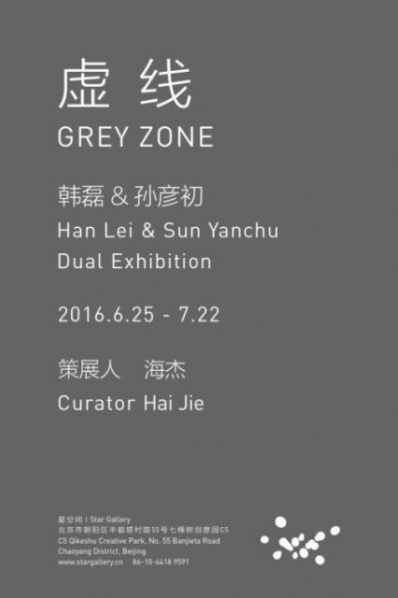
Preface
By Hai Jie
Grey zone, as a visually distinguishable symbol, marks a a grey area in traffic rules, signaling acceleration, turning and changing lanes, it’s part of a regulatory mechanism to allow the driver to exercise free will in traffic control. The two artists of this exhibition, Han Lei and Sun Yanchu, their art practices fully embody mechanism of the “dotted lines” while reaching for wider linguistic boundaries and image logic.
Moreover, the reason for simultaneously exhibiting these two artists is, on the one hand, based on their place of origin, both are natives of Henan province; on the other hand, based on the interactive elements between their works. Sun Yanchu enjoys wandering around aimlessly, and what he encounters are the withered grass, dried branches, stray dogs, untrodden path and roaming caravans on the central plain’s wilderness… these resonate with his state of mind and mirror his existence. This lyricism born and grew out madly from the change of hands with the wilderness lights up Sun Yanchu’s restless mind, he relies on such lyricism to release his frustration and violence, making room to store joy and peacefulness.
For him, taking photographs is like “venting his hatred”: a way to release energy and extend their visual impact.
The darkness, eroticism and violence visualized through the shutter and the darkroom processing, share similarities with Han Lei’s earlier works: whether in the series of voluptuous portraits of various figures, or the images of clowns and nude women, or the “folk punishment” rooted in the countryside.
However, what we would like to show is the shift towards the dotted line logic of image. In Han Lei’s recent works, he’s used optical grating material to make portraits of female TV stars or collected images of anonymous women, to evoke memories of another time and enigmatic way of viewing associated to it. Optical grating material were often used in advertisements and households items, for example, framed in with a landscape hanging in a household living room, one would perceive the various scenes by standing at various angles from the image. He brought his seemingly defunct technology to the current context and believes it’s the most suitable medium for his practice. The images he adopted in the recent optical grating photographs are selected from a wider range of source images, for example, flowers and archival photographs of famous sculptures, he asserts the different viewing effect of the same image into one work (for example the effect of the photograph and its negative), or of different photographs. This reminds us, other than digging into our memories, Han Lei is equally asking us to question the way of viewing. Among these works, we have to move about to look at the image, rather than standing at one place and gaze into it, the glittering effect of the image and the viewer’s “de-centered” positions, change the viewer’s experience, in other words, these images were once stared at now demand the viewer to move about in order to get to the closest viewing point of the image. In discovering this perspective, Han Lei has in turn manipulated the meaning of image production, as well as setting forth a playful tactic to one’s viewing habit, he hopes the viewer would be more diligent, that they would remain uncertain of a satisfying perspective. Moreover, the best viewing position discovered through moving back and forth is neither the best point of looking at the photograph, nor does it follow the viewing logic of a linearly progressed film, but a temporary shelter that falls between photograph and cinema.
Based on common short video clips of advertisements played by film stars, slowing them down, taking out of its commercial functions, and extend those void and unnoticeable moments into theatrical rituals, making the dancing flags printed with those images of film stars to become a playful allegory.
Sun Yanchu’s Lost Souls series differs from his earlier encounters to fight against reality. It captures the crossroad on in his journey when he passes by in a flash second – this is the best path to “return to the countryside”. The quick-flash to provokes the artist’s certain anxiety and restlessness, “rapidly” driving through allows such “quick-flash” to embody a semi-hypnotic viewing experience and a spiritual image of returning to the countryside. The shooting command executed by the shutter resonates with the works of the charcoal drawing, and with his use of silk, Sun Yanchu tests the ambiguous zone between looking at a photograph and a drawing. In other words, he has intentionally blurred the boundary between the two mediums; in his new 6 x 6 Dust in The Wind, what seems like outdoor photography used “staging”, to capture the desired image, and through “selection”, an evenly staged image expands into a dangerous, bewildering and humorous theatre; in Fiction, perhaps due to his experience of constantly looking at images, or the influence of his father, who used to paint for the neighbors and people in the village during his childhood, Sun Yanchu adopts the medium of painting to his photography. Through “editing” and “smearing”, he undermines the existing semantics of the image, his appropriation of rural murder stories found in the media and images that mark a sense of time engenders new scenarios and a greater narrative logic of the image through covering, collaging and satirizing the images. As the viewers, we see the middle ground between these two narratives through the remnants of the original image.
About the exhibition
Date: June 25 – July 22, 2016
Venue: Star Gallery
Courtesy of the artist and Star Gallery.




























